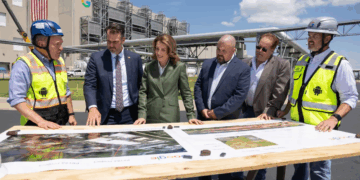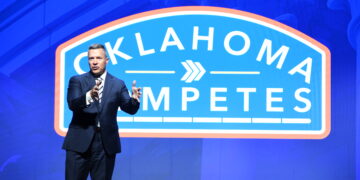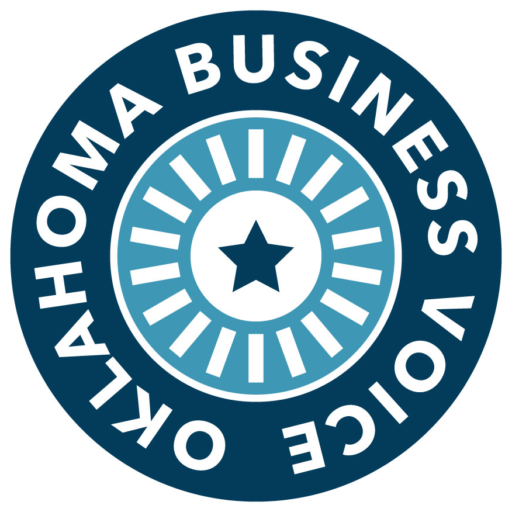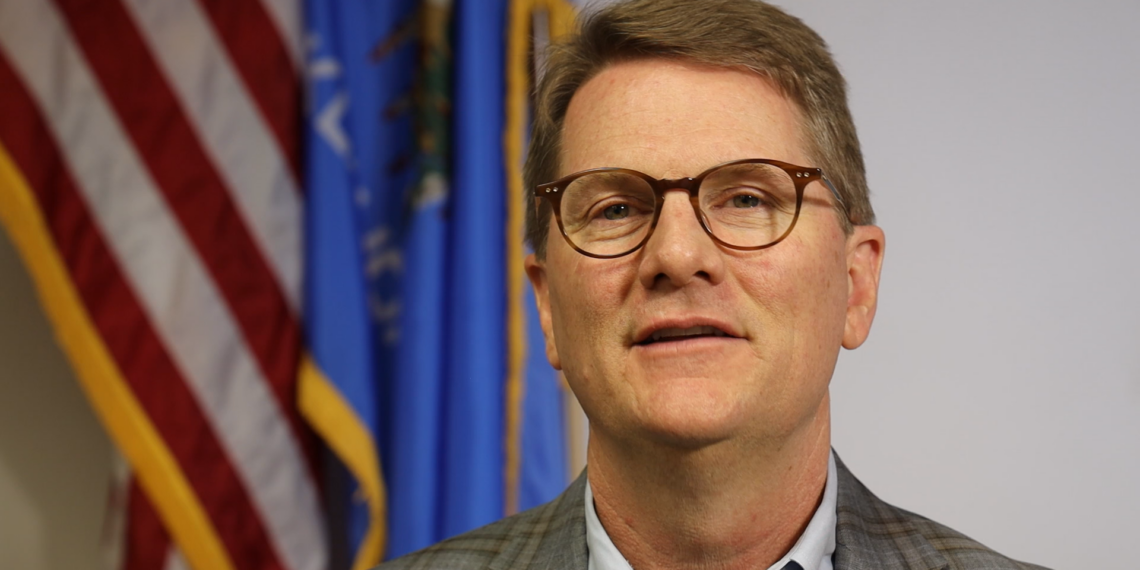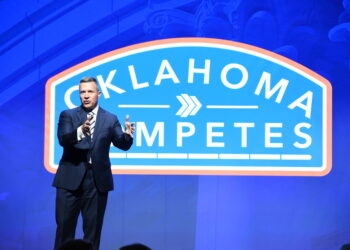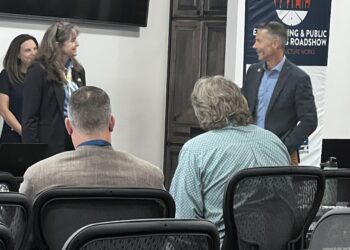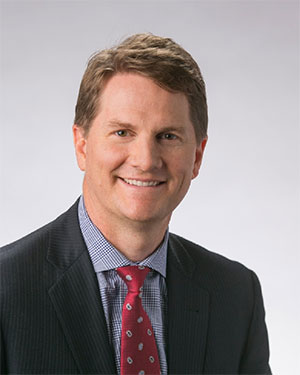
OKLAHOMA CITY (OBV) – Tim Pehrson is a busy Oklahoma leader. He is the president and CEO of INTEGRIS Health, which, with 16 hospitals across the state, is the largest health care system in Oklahoma. He is also the chairman of the Oklahoma Workforce Commission, which was created to coordinate the state’s workforce efforts and streamline workforce processes into a more efficient and effective system that will grow the economy and produce greater numbers of skilled workers.
Pehrson, however, took time to sit down with Oklahoma Business Voice and speak one on one about a wide range of important issues impacting Oklahomans, including health care developments, nursing shortages and growing Oklahoma’s workforce and economy.
The full one-on-one interview with Pehrson is shared below:
You have been president and CEO of INTEGRIS for going on six years, yes?
Pehrson: In July, it’ll be six years.
How would you describe INTEGRIS’ growth as one of the leading medical care providers in Oklahoma during that time?
Pehrson: So, for the last several years, we’ve seen significant growth, over 60 percent growth in top line. We’ve expanded the number of facilities. In fact, we just acquired the Ponca and Woodward hospitals and continue to see intake growing with the community as an organization like ours should.
How would you describe INTEGRIS’ presence across the state? And does INTEGRIS have a presence in every region throughout Oklahoma?
Pehrson: INTEGRIS Health is the largest health system of the state; we’re in a lot of places. We’re not in Southeast Oklahoma and we’re also not immediately in Tulsa. We’re around Tulsa, but not in Tulsa. And we’re a very strong presence here in Oklahoma City and Northern and Western Oklahoma. We have 19 hospitals, hundreds of clinics, lots going on in ancillary services around the state and particularly in the metro OKC area.
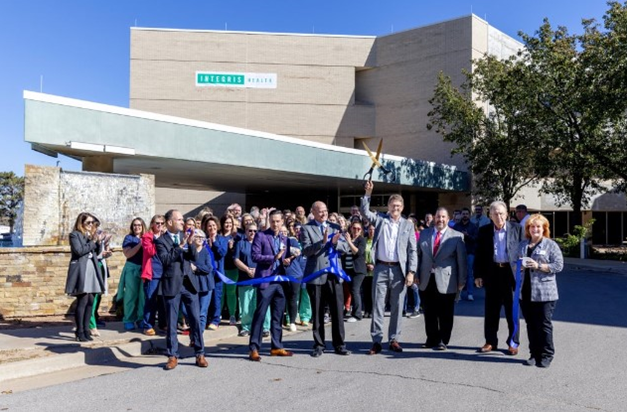
Would you say there are plans or hopes to expand into those regions where INTEGRIS is not currently present?
Pehrson: We want to be the the most trusted partner for health, and that obviously includes being where Oklahomans are. So, we’re always looking for opportunities.
What changes, developments and innovations at INTEGRIS are you most proud of?
Pehrson: One of the things that I’m most proud of is this concept of clinical programs. Clinical programs is an organized way to think about delivering care. Health care is very complex and it’s a team sport. And often the way that physicians and nurses are trained is somewhat siloed. So, we’ve brought a process, like I said, that’s called clinical programs where physicians, other clinicians, leaders, statisticians look in at the kinds of care that’s being delivered and the outcomes, and then look to design or redesign that care process.
For example, we’ll look at heart services and figure out the best care pathway and then organize the care throughout the organization in a way that delivers the evidence-based best practice care. And that just wasn’t happening broadly across the state. And so, we’re really excited about what we’re able to deliver, and we’re seeing improved quality outcomes and improved cost outcomes from the work of clinical programs.
Can you give us a look ahead at INTEGRIS? What can you tell us about INTEGRIS’ future growth as far as incorporating new medical innovations, new approaches to patient care and physical growth throughout the state?
Yes, so [regarding] physical growth, I’d just say if you drive past INTEGRIS Baptist Medical Center, which is a large tertiary medical center that does the most transplants in the state, all the burn care, etc., we are building a $200-million heart hospital. We’ve delivered extensive heart care; in fact, we’re the only place that does significant soup to nuts heart care services from basic heart care to LVADs (left ventricular assist devices) to mechanical support to transplants.
So, that new facility is coming online here in July-ish. And you’ll also notice, particularly across the metro right now, there are 20 new urgent cares that are being opened. Several have already been opened. They’re called all-set urgent cares; INTEGRIS Health has those. And then the other thing that from an innovative perspective, in the last two years since the pandemic, we’ve experimented with this concept called Hospital @ Home. This is actually not home care. It’s actual hospitalization delivered at home. We do that through a tech stack that we bring out with providers that come into the home and through video communication with the patient where we can actually care for them as a hospitalized patient in the comfort of their home, which has been really fun to see and work on and really get that ball rolling.
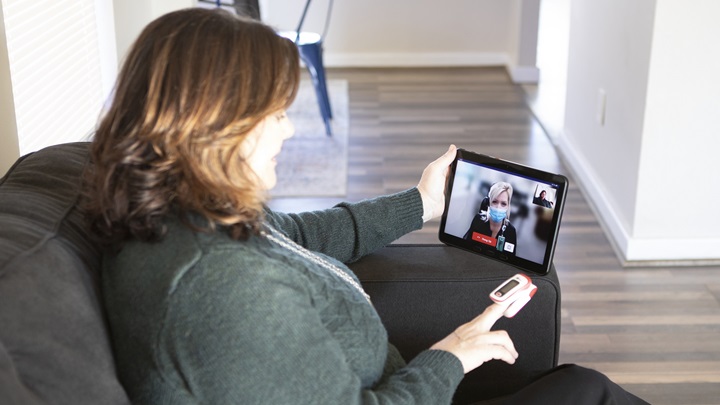
How has the patient engagement been on the Hospital @ Home innovation?
Pehrson: Safety, quality, all better patient satisfaction – significantly better. They love it. There’s always some nervousness at first when you say we need to be hospitalized, but we can take care of you at home. And people say, wait a second. But once we explain what the program is and how we administer it, people get very comfortable quickly. And then when they actually experience it, it’s a great experience.
Workforce is an essential part of of the hospital industry as it is with any industry in the state. It’s a major concern. How would you describe the state of workforce in Oklahoma’s health care industry?
Pehrson: So, shortages would just be the the the term, right? I mean, we don’t have enough nurses. We could open up significantly more beds. We actually have the physical beds to open up, but we don’t have people to help them be opened. So it’s a big problem. It’s a problem across the country. And nursing shortages kind of ebb and flow often when the economy gets hot.
Seems like nurses turn their attention to looking outside of health care, and when it cools off, they tend to be interested in coming back. Also, I think the pandemic created some pretty hard challenges for those nurses, particularly, and other clinical caregivers. It was hard, right? It was very hard. While the rest of us got to sit in our pajamas and Zoom, they were actually in the frontline in personal protective equipment, taking care of people that were dying at unprecedented rates.
So, it’s very challenging, mentally stressful. But I think one of the good things about nurses is they generally get into this, and really at most clinicians, get into this business to do the right thing, to do good. And as they’ve kind of stepped back from the pandemic and looked at the great things that they’re doing, there’s this revitalization of the workforce, and there’s a pretty big interest in becoming a clinician in our state and really across the country.
But we’ve got to be smarter about the way we educate them. We got to be meet the workforce where they need to be met in order to get them the degrees that they need to be able to get.
Speaking about the the nursing shortage, Oklahoma ranked 46th in the nation for nurses per capita last year. The Bureau of Labor Statistics, they had it at 7.5 nurses for every thousand residents. You touched upon the brunt of the pandemic being one of the primary reasons for the shortage. Are there any other reasons for the severe nursing shortage in the state?
Pehrson: I would say there’s a nursing shortage across the country. So Oklahoma is not unique. We just have a more stark difference than some of those other states that have invested in creating training programs for nurses. We haven’t been as creative as we need to be now. That’s starting to change. I know that many of the universities, including our major universities, are leaning into this very hard to look for innovative ways to train more nurses.
But it takes time, right? I mean, you say you want a nurse, [but] if it’s a bachelor’s degree nurse, it’s four years, right? So you don’t get a nurse tomorrow when you say you want a nurse tomorrow. It does take some time. So, I think there’s some good solutions in place. But we’ve got to get more creative and maybe hear some of the things that I’m thinking about. You look at, for example, our vo-techs, they have an open enrollment process. People can come in and start and stop when they want on other degrees, right? Not specifically in nursing, but they can kind of come in and start stop. That’s one of the things I think becomes appealing. I think we’ve got to look at where people are. A lot of times people want to go into this business, but maybe they have a couple of kids and they got a job. And so, how do we create on-demand training for people so that when they work their one or two jobs, they get their kids to bed at night and they got two hours to take a class? Right now, if you want to try and do that in a lot of institutions, we can’t deliver that because we deliver it in a traditional fashion. So, more creativity needs to be established around that. And I think that we will get people into those environments that want to be involved. They just are limited by their current situation.
Is there a way to further incentivize people to become nurses?
Pehrson: Many, many states have taken advantage, and we’ve done a little bit of that where we incentivize students to go to school. I think with the expectation to live and work in Oklahoma as opposed to get that degree and go to Texas or somewhere else for that. So, we’ve got to be smart about that.
But again, really to me, it’s about meeting people where they are. And health care is a great place to create a career because there’s growth. So, a lot of times people don’t think that they can become a nurse or a doctor. “I’m not smart enough” or whatever. We can start them at levels of care where they can actually go in and be a a medical tech or a medical assistant or a certified nurse assistant.
And then once they gain confidence that they’re like, “Hey, I can actually do this,” but if we’re not creative, then we can’t help them progress because they’ve got life to live and bills to pay and so forth. So, again, kind of going back to that on-demand capability is going to be really important. And then, you know, we’ve got to do more as an industry to create places that they can now actually come and do their clinical rotations. You can’t be inundated by a bunch of students at the same time. So, it’s sort of figuring out how to titrate the students and to give them the experiences, because a lot of health care is the didactic work, but also the on-the-job training type of thing. But we are working to do that right now.
I know other health systems are doing the same thing, so a lot of work is being had here. It just takes time to have it actually take impact.
In 2017, the CDC ranked Oklahoma first in the nation in heart disease as a cause of death. Fourth in cancer, second in chronic lower respiratory disease, ninth in stroke, fourth in diabetes and fifth in chronic liver disease/cirrhosis. Alarming numbers. Besides the obvious concern over the health and well-being of Oklahomans, how do such scary health outcomes impact workforce in our state?
Pehrson: I mean, what you see is that Oklahomans are unhealthy compared to other states, right? And so that drives the need for more health care services, which is not great, right? We want a healthy workforce. We want people to live their fullest lives. If you look at the underlying causes of most of those disease, it’s obesity.
And it’s lifestyle things, smoking, drinking, all those kinds of things that create those poor health outcomes. So, we have to be thinking differently as a state and, as business leaders, to say, “What can we do to help?” And we’re not going to be a nanny state. But what kind of incentives can we put in place to help people live healthier?
And I think that if the businesses and the state government want to get serious about improving those health metrics, we have to focus from a policy perspective on what are the things that we want to change. And we’ve done that actually, just recently, on two large pieces of legislation – one of them was a vote of the people.
But actually, the House and the Senate passed some legislation that would expand health care to the Medicaid population; that happened a couple of years ago. That’s a very important thing. Second, is we did some Medicaid reform that changed the fundamental way that we’re going to deliver and finance the care, and over the long run, it will be focused on how we keep people healthy. So, there will be incentives to keep people healthy rather than just take care of people when they’re sick. We’ll obviously take care of people when they’re sick, but we’ll be rewarded to keep people healthy and well. So, those are some big policy moves that are starting to happen and what really impacts the health immediately. The other thing that we’ve got to do is we got to stay long-term focused because it’s a five-to-seven year path, 15-year path to get into real, better health.
In some cases, those diseases that you talked about are not going to be cured. Those are chronic diseases. Those aren’t going to be cured today. But we’ve got to talk about what’s happening with the rising generation. And that’s what I think is important about getting our arms around the policy objectives that need to be accomplished by the businesses in the state to help this rising generation be healthy.
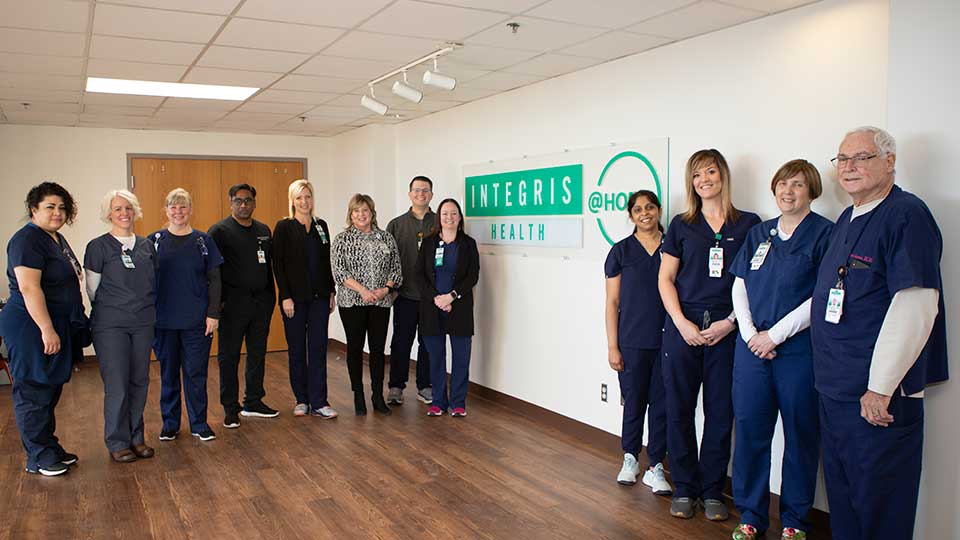
What would you say are the primary health concerns that are impacting Oklahomans, especially that are having a direct impact on the workforce?
Pehrson: Well, I mean, you just listed every single one of them that we were the worst in. So, if you have got heart disease, if you’ve got hypertension, if you’ve got diabetes, all those things help you to be less healthy and often require you to be out of the workforce, getting medical care. And so you can’t be as productive as you would want to be or as employers would want them to be, because you can’t, you’re physically hampered.
So, those are the health challenges. And as a result, that does drive some of the need for additional health care workforce to take care of those people. I would actually rather wrap services around those individuals to keep them well, require less people because we’ve got plenty of work for the people that are already here and help help drive healthier outcomes for the poor.
You touched upon legislative policies that are being put forth to address this concern. But what are some things that companies across Oklahomans can do to get their workers healthier or help their workers become healthier?
Pehrson: Yeah. Let me just say, I think it’s admirable that all the companies will get together and try to keep their workforces healthy. I think that’s great. But, I mean, we just got to be honest. Our workforce kind of ebbs and flows between all of our companies. So, we need to sort of start taking a bigger picture, look at things and say, “What do we need to be doing for Oklahoma?” Not just for my company, not just INTEGRIS Health or whatever other companies are out doing their own creative things. Because the reality is that that’s going to impact long term the people that are going to come to work for us. So, for me, what it means is that as a Chamber, we need to be leaning into these issues as a policy group and thinkers and taking some ideas and solutions to the legislature that are long-term thinking. We’ve done that in some tax policies. I was at the State Chamber Board meeting recently. We looked at some scorecards of some work that we’ve done over the last five or six years, and it’s made a difference.
So we have to lean into this as business leaders, as a collective group, because you can’t solve the health of a population through a single or even a handful of individual businesses. But collectively we can come forward and say, “We’re going to fix this,” whatever it is: education, transportation, roads, our health care. But we’ve got to do it now. And I’m convinced that we can move to 35 by ’35. Right now, we’re 47. Even though INTEGRIS Health is the largest health care employer in the state, it is not going to happen with INTEGRIS Health.
We can be a thought leader. We can be a partner. But the collective business community rallying together to work with our elected officials can really provide the policy pieces in place to help improve the health. And if we don’t get to 35 by ’35 and we get to 40, we’re seven spots better. And that is life, those are people’s lives. Those are our kids, grandkids, our neighbors, our friends. So, now is the time to fix this; we have to lean into this. And so, we’re working with The State Chamber to develop this agenda, and then with, obviously, our elected officials to drive better health. It’s got to happen. If we don’t do it together, it won’t happen.
And the other thing that we can’t get discouraged with is we have to take a long-term strategy because sometimes we’ll do things and we say, “It didn’t work.” Three years later, guess what? This stuff moves glacially. And so if you make policy changes, it’s a seven, eight, 15-year run, and that’s kind of like what we’ve done in the state.
We’ve not had a strategy for the state on workforce or economic development. And now the state has done a great thing in partnership with the Chamber to create a Workforce Commission, to create a long-term strategy for workforce that’s looking out and saying, “Where do we want to be in the next 15, 20 years, and what’s the groundwork that we need to lay?” And then right now, the Senate has a bill out there from Sen. [Kristen] Thompson, and there’s several others around economic development. But trying to do the same kind of things that we’re doing, a workforce that sort of is lasting beyond any elected official or whatever, but creates that long-term strategy. And this stuff works.
I mean, we did an extensive study on places like Virginia, Ohio, Utah, some parts of Texas that took this longer term approach. And now, they look back 15, 20 years and they actually are achieving the things that they set out to achieve because they stayed focused. They created their policies and they actually achieved them. And that’s what Oklahomans do.
And by the way, we are ripe to be the next Virginia in terms of workforce and economic development. But if we don’t get our arms around it and as a business community and as elected officials, it won’t happen, right? And so these structures that are currently put in place for workforce, although early in the game, and what we’re trying to do with economic development, I believe are really important. Twenty years from now, our kids are going to be thanking us because we will have created an environment that has a thriving economy that’s going to continue to grow and grow at a rapid pace.
You’re the head of the Oklahoma Workforce Commission. What would you say is the purpose and function of the Workforce Commission?
Pehrson: So, the Workforce Commission is a group of nine business leaders that are appointed by the governor and the legislature to create this long-term strategy for workforce. And it needs to be deeply tied to our elected officials, but yet also sort of outside so we can keep the ball looking down the field 20, 30 years from now. And this is what the the states that have been very successful in their workforce efforts have done.
So, we’re very early in the game. They’re all business leaders and we’re establishing where eventually we’re going to be like a board as opposed to the ones that are doing a lot of the work. But right now we’re doing quite a bit of the work to spin up what’s called an implementation office with a CEO that will be leading the charge that is armed with data to be able to look, look out and see what we need to do and how we can accomplish some things. And then to organize the funding in a way that will say, “Okay, these are going to be our state’s priorities over the next little while.” Now, again, obviously, the legislature is going to have the ultimate decisions in terms of the purse, but we want to provide them with credible options that they can trust and rely upon.
If you go to Virginia, their legislature really leans on their workforce-like commission to say, “Hey, where are we? Where do we need to go?” And they can trust it, and they’ve been able to trust it and then fund it. So, that’s exciting. We’re a little bit early in the game because the workforce was done before the economic development piece. Again, as I mentioned earlier, that’s working its way through the legislature, and I’m very hopeful that we’ll get to a good spot there. But we’ve got to do the same thing on economic development, because doing a workforce plan, independent of economic development, is sort of like flying blind a little bit, right? I can’t go out and create a plan without that.
So, we’re going to be tied in. But in the meantime, we’re working on splitting this implementation office up. We’re working on getting additional funds to help support the administrative functions that need to go into making sure that we get the data to our elected officials to make good decisions around that and being positioned so that when economic development is tackled, that workforce can just work hand in glove together to create this long term vision for the state.

The Workforce Commission has had a few meetings so far. How have those meetings went, and have there been any notable accomplishments thus far?
Pehrson: So, the meetings have been great. It’s more of a process of educating us as a Workforce Commission about what’s already out there. I think one of the things that was clear is that when the Workforce Commission was put together, it made some people nervous. And so, we wanted to bring those individuals and groups in that might be nervous to think, “Oh no, what are these people going to come in and do?” The reality is we just need to understand what they are doing and then see what we can do to help organize it and point it in the direction that we think the state needs to go over the long run. So, really, the last several meetings have been bringing those interested partners in. We also brought in the bill sponsors to share their vision of the bill. We obviously can read the bill, but it’s nice to hear from the authors of those bills. And then working now to kind of organize the efforts of getting the implementation office up to speed. So, that’s kind of where we are. We’re early in the process. We got nine executives on this commission. We’re all kind of, “Move, move, move, let’s go.”
And we’re realizing that some of the stuff just takes some time. And we also have day jobs. So, it’s obviously not moving as fast as we’d like, but we’re putting the foundation in place, and I think we’re going slow so that we can go fast. Once we get this position hired, of the CEO of this implementation office, she or he can take the ball and really move forward. And then what we can be accountable for is much like a board holding the management accountable to deliver on the long term strategy and vision that we set. So, it’s early in the game, but it’s exciting. We need economic development to get done in the state so that we can partner with that arm to drive the state’s agenda forward.
Is part of the Workforce Commission’s function making recommendations to the legislators as far as legislation that will grow workforce? Is it making recommendations to education?
Pehrson: It will do all of those things. It hasn’t done those things yet. We want to be a trusted source of information and a coalescer of ideas for Oklahoma. That’s what we want to be able to do, and then work with the folks who are hired to do the appropriations, to work with us to to maximize those dollars that come into the state and come from the state and come into the state.
Has the Workforce Commission established any first-year goals or goals for two years down the line or three years down the line?
Pehrson: So, we haven’t done [goals] for three years. Our first-year goal is to get the additional funding, to get the implementation office spun up, to hire the CEO, to get the data sources in place and the funding for the data sources in place and then that team starts to create with us the long-term strategy. So, we’re very early in the game.
There are some education bills in the legislature that are geared toward growing Oklahoma’s future workforce. One expands high school graduation requirements by creating new pathways, which include career readiness training. The other creates the Workforce Development Revolving Fund for the Oklahoma State Regents of Higher Education. How are those bills essential to growing the state’s workforce? And how significant is education to workforce development?
Pehrson: I really like Sen. [Adam] Pugh’s bill that gives us the opportunity to focus on a couple of key areas or degrees to incentivize those and to reward institutions and students to get into those and complete those. So, I think those are great.
Rep. [Rhonda] Baker’s bill is is creative. I think it’s important to get to kids early in the K-12 and find ways to get them involved. I was talking to Superintendent McDaniel of the OKC public school system. I think 60 percent of the kids that graduate from high school will not go on to any further education, and I know that that’s a concern. But why not get in front of them early to help them understand what career opportunities are, right? Maybe a four-year degree isn’t their stick. But, by the way, we got some awesome vo-techs that can make these folks productive. Become a welder, become a composite tech and work out at Tinker; become a plumber, a journeyman electrician.
These are the kinds of things we’ve got to expose our kids to because there’s opportunities out there for them to get creative and be productive members of the workforce.
I also really appreciate what Sen. Pugh is trying to do in terms of creating a revolving fund that allows us to be quick and on the fly, to use the dollars in a way that will incentivize the things that we want to incentivize quickly as well as on a long-term perspective. So, I’m excited about the initial proposal.
You touched upon economic development and Sen. Kristen Thompson’s bill establishing OkEDGE, which creates an entity within the Department of Commerce that will be focused on economic development and business recruitment and retention. How do you see that entity working with the Workforce Commission as far as developing Oklahoma’s future workforce and synergize that effort with recruiting companies into Oklahoma?
Pehrson: I think as I’ve said in the past, workforce is one big aspect of a plan. The other is economic development. I can go out with our Workforce Commission and create a plan for workforce, but if I don’t know what the economic development plans are, it will be off. So, we have to be working together and we need that same long-term focus from economic development that we’re trying to establish in workforce. When we know what that is, we can do it.
I happened to be in another state for a number of years and they said, “We want to be in life sciences. We want to be in computer tech. We want to be in aerospace.” And so they had a plan, right? They said, “These are the industries that we want to be strong.” They put incentives in place to do that. Then the workforce part of that was able to say, “Okay, well, that’s the plan. Let’s figure out how we get you the workforce to do what you need to do.” That’s what we need and it needs to be focused. It’s great that when Tesla says, “Hey, we’re thinking about putting the plant in Oklahoma,” we should go after that, or Panasonic, right? But that shouldn’t be our economic development. Our economic development plan should be long term. “Where do we want to be? What kind of services do we want to provide? What do we want to be known for in the country?” And when we put that stake in the ground, that allows the legislature to fund things that are consistent with that strategic plan.
And we can do the same thing on workforce and go to the legislature and say, “Hey, if we want these, we’ve got to have this for the workforce.” So they’re really hand in glove. We got to get this thing done. Bills have their own lives, right? They kind of bob and weave in a legislative session. But we’ve got to do something different. This is really important for Oklahoma to get the economic development stake in the ground. And then let’s hold them accountable. You guys can hold the Workforce Commission accountable. Together, we will create a winning strategy for Oklahoma, because this is a great place to work, live, play. We need to make sure that we are creating jobs for the future, and this is how you do it. This is how the states that have done it, and we can do it. We’re just as smart as them.




